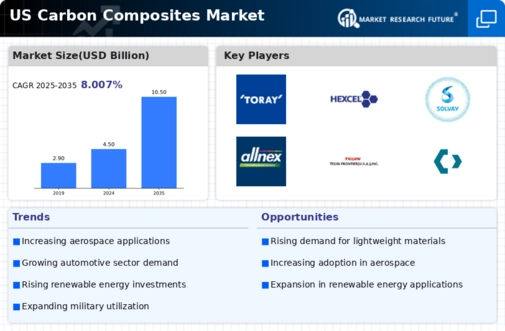The US Carbon Composites Market is characterized by a dynamic competitive landscape that is shaped by various factors, including technological advancements, growing demand across multiple sectors, and the strategic positioning of key players. The market has witnessed significant evolution with the introduction of lightweight and high-performance carbon composite materials, which are increasingly being favored in industries such as aerospace, automotive, and sporting goods. Competition within the industry is intense, with companies striving to innovate and enhance their production capabilities while also navigating regulatory challenges and market fluctuations.
Comprehensive understanding of market trends, customer preferences, and competitor strategies is critical for organizations aiming to establish a strong foothold and achieve sustainable growth in this sector. Kordsa Teknik Tekstil A.S. is recognized in the US Carbon Composites Market for its robust manufacturing capabilities and innovative product offerings. The company's strengths lie in its advanced technological approach to producing carbon composite materials that cater primarily to the transportation and aerospace industries. Kordsa's emphasis on research and development has enabled it to create high-performance fiber products that enhance the durability and efficiency of various applications.
Their commitment to sustainability, alongside efficient production processes, has positioned Kordsa as a leader in the market. With a well-established network for distribution and collaborations with key manufacturers, Kordsa Teknik Tekstil A.S. continues to strengthen its market presence in the US, leveraging its technical expertise to meet evolving consumer demands. Toray Industries operates with a strong market presence in the US Carbon Composites Market, bringing forth a diverse portfolio of products that cater to various sectors, including defense, aerospace, and automotive.
The company's key offerings include advanced carbon fiber and fabric materials known for their strength, weight efficiency, and thermal stability. Toray's significant investments in research and development have led to breakthroughs in composite technology, further enhancing its reputation within the industry. The company has engaged in several strategic partnerships and acquisitions aimed at expanding its manufacturing capacity and enhancing its product range, thereby increasing its competitive advantage. Through its focus on innovation and sustainability, Toray Industries cultivates a strong position in the US market, addressing the needs of customers looking for high-performance composite solutions that align with environmental standards.





















Leave a Comment